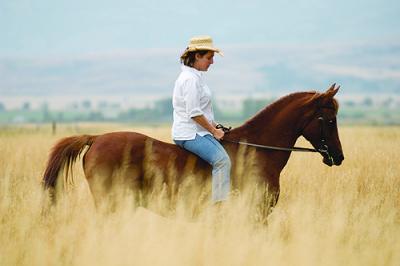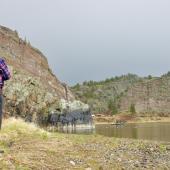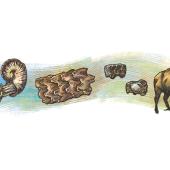People Healing Horses, Horses Healing People
Montana's Real Horse Whisperers

The horse had been overtrained, always expected to perform. He was tense, not unlike Type A people. To get him out of this mode for weeks Catherine Nelson put her hands all over his body until he trusted her. She encouraged him to hold his head down in a relaxed manner and breathe. He became softer, yet still sensitive and aware. The two approaches she uses to work with horses are TTOUCH, developed by Linda Tellington-Jones, and Pat Parelli’s highly structured natural horsemanship program.
Catherine says, “The methods are similar and different. TTOUCH involves a lot of hands-on bodywork: with the ears, tail, legs, inside the mouth, all over the horse’s body to help the horse come into balance physically, mentally, and emotionally. The Parelli method focuses on relationship and trust between horse and rider. Both programs involve groundwork techniques and riding as well as kind and gentle ways of training a horse.”
We need to understand that horses are prey animals, that they see potential danger everywhere unless trust and faith are established. Furthermore, horses have been abused, neglected, exploited and abandoned, not to mention sent to their deaths way before their time. They suffer joint pain, muscle and tendon strains, just as we do, especially in some accidental fall.
The modalities individuals use on injured horses are similar in name to what they use on people but different in application. They include chiropractic, craniosacral therapy, massage, structural integration, TTOUCH, and acupuncture.
Some horse healers also operate sanctuaries. Deborah Derr’s United in Light establishment in Livingston, surrounded by the spectacular peaks of the Absaroka Mountains, exudes peace and contentment. She moved here with four old, arthritic draft horses in 2007. All the horses were saved from slaughter and are now free to live in retirement.
Working with energy guidance as a Reiki Master, using a cold laser, and employing chiropractic moves, she maintains the health of her horses. (Reiki is a Japanese technique for stress reduction and relaxation. It is based on the idea that a life force energy flows through a body; if it is low, we are more likely to get sick; if high, we feel healthy and happy.) Currently she is raising funds for a shelter to protect the horses from the weather. She has a matching grant for a 20x80 one if she raises $3,000 more. (All donations welcome).
Moonshadow, now 29 years old, was found in a tight stall in a barn; he hadn’t seen daylight in 20 years. Fearful of everything, it took two years for Deborah to acclimate him to the corral and the other horses. Now when there is a newcomer, he’s the one who shows where the hay is or the water.
Another horse was shipped all the way from Pennsylvania with a fractured pelvis. He couldn’t put weight on his back legs and walked tippy toes. She adjusted him and did energy work. She’d do strokes and hands-on positions for pain and inflammation in his nervous system and joints.

Deborah says, “People come to visit not knowing why they’re here. Some cry, but leave smiling.” See the Web site for the backgrounds and pictures of the horses. She welcomes volunteers.
See www.distinctlymontana.com for info about Jane Heath’s healing work and her Montana Horse Sanctuary near Helena.
Lee De Rham grew up in Gallatin Gateway on a large ranch surrounded by horses. She began offering craniosacral therapy to people but then started working more with horses.
She got into healing because of a back problem the medical community couldn’t fix. She had MRIs, physical therapy, chiropractic, and couldn’t get past a certain level without pain. Until one day she tried craniosacral therapy. She improved and felt that she had to get licensed.
Her first patient was her own 31-year-old horse who recently died, living four-five years longer than expected. Once he fell on ice and jammed his knee into his shoulder. It was so extremely painful that the vet thought he’d need to be put down. She stayed with him for three weeks, using her techniques and finally felt the leg drop down from the shoulder. That began his recovery.
April Johnston calls herself an Advanced Equine Equilibrium Structural Integration Practitioner.
Like Lee, she goes to people’s houses and barns to work where they are, even to the East Coast. She offers a free consultation followed by a five-part series two weeks apart of progressive bodywork sessions to release tension patterns in connective tissues and muscles. The pressure applied is much stronger than in TTOUCH or massage or craniosacral. Because tissues lose elasticity, first she works on the outer layer of fascia, and then goes deeper, releasing restrictions of movement.
“Horses heal me,” she said. “I broke my back on a horse being really careless and reckless when I was 18. I was in the hospital, had body casts, and spent 14-15 years in pain, trying different treatments. I was becoming more and more crippled. Thought I’d have to quit my job as a Sr. Biologist in FL and then as a nonprofit executive in Bozeman. I heard about structural integration and experienced profound relief in 10 sessions.” When I visited her, April sat comfortably curled up in an easy chair with no evident restriction of movement. She says, “Horses have brought me more peace and relaxation. As a healer of horses, I’ve gotten my health back.”

Sid Gustafson, DMV, well-known throughout Montana and beyond, offers comprehensive veterinary services, dentistry, surgery, house calls, behavior training, day care, and much more. He uses holistic health nutrition, massage, and chiropractic thrusts. His Web site is full of videos, instructional articles, and blogposts. He is also the author of the award-winning book, Horses They Rode, in addition to books on horsemanship.
Raised on a ranch, he rode with Native Americans and says that he was “raised by horses.” He teaches equine behavior at Guelph University in Canada. He’s treated race horses and written articles for the New York Times on Kentucky Derbys.
Dr. Sid says that stabling and interval feeding of horses cause problems because their heritage is free movement, regular grazing, and being among a herd. They need to have forage in front of them constantly—bland hay—friends, and abundant locomotion.
Dr. Sid’s goal: “making the world a better place for horses and horsefolk.”
It’s phenomenal how often healers get into working with horses because of their own injuries. The aforementioned Catherine Nelson had had a neck fusion and thought she’d never ride again but friends at Parelli trainings helped her past that fear. Deborah Derr turned her life toward animals after a near-death experience. Lee deRham had persistent back pain, and only craniosacral therapy released it. April Johnston had broken her back and learned about structural integration.
When I ask people, “How do horses heal you,” the most frequent answers are feeling love, learning to be present, and how to establish a connection. But healings go deeper than that. Love and faith between the person and the horse enable people to overcome feeling wounded, condemned, and rejected.
For instance, a woman who had rescued an abandoned horse, had lost her mother when she was very young and the woman never felt cared for. The woman felt the horse was more open and affectionate than she was. When the horse died from cancer, Susan grieved for her as well as for the little girl inside her who had not grieved the loss of her mother.
When Bobbie Crossguns (Equine-assisted Integration) was three, she was run over by the wheel of a car. Her right bronchial tube was smashed. In the hospital, she learned to observe nuances in facial expressions, body language, and needs. During this time she always loved and trained horses.
While working as a lawyer for the state of Montana, she practiced “equine-assisted integration.” In 2012, she plans to do training and manage her horse farm full-time, offer clinics and week long retreats during some of which people will sleep in tipis.
Her patients include severely emotionally disturbed people, ex-convicts, addicts, war veterans, and children. She shows them how to be in a safe relationship with a 1,200-pound horse, beginning with the soothing act of brushing the length of its warm body. A physical bond starts with touch—the sniffing of a soft muzzle—and the look of large gentle eyes. Emotional rapport comes when the human realizes how unconditional horses are in caring. Even an hour leads to increased confidence. She videotapes a client’s progress so they can see where their or the horse’s body shows stress.
For information about the amazing programs at Eagle Mount in Bozeman, directed by Maggee Harrison, see www.distinctlymontana.com.
Bobbie CrossGuns’ virtues are...
Be present
Have an open heart
Find truth
Find wisdom in objectivity
These make good life lessons too whether applied to a love or business partner or friend.
Contact information for practitioners mentioned in this article:
Catherine Nelson, Bozeman
Deborah Derr, United in Light, Livingston
Lee deRham, Gallatin Gateway
Integrative Health Therapy / CranioSacral Therapy / Massage Therapy
April Johnston, Bozeman
Equine Equilibrium LLC
Sid Gustafson, Big Sky
Big Sky Clinic
Bobbie CrossGuns, Helena
www.spirithorsesofmt.qwestoffice.net
Maggee Harrison, Bozeman
Don Funke, Bozeman
Chiropractor
Jane Heath, Simms
Montana Horse Sanctuary
Here is a helpful Web site listing other horse sanctuaries around Montana,
www.naturalhorsetraining.com/mt-horserescues.html
Valerie Harms is the Editor of this magazine.












Leave a Comment Here